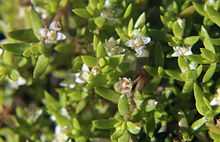Crassula helmsii
| Crassula helmsii | |
|---|---|
 | |
| shrubs and flowers of C. helmsii | |
| Scientific classification | |
| Kingdom: | Plantae |
| Division: | Magnoliophyta |
| Class: | Magnoliopsida |
| Order: | Saxifragales |
| Family: | Crassulaceae |
| Genus: | Crassula |
| Species: | C. helmsii |
| Binomial name | |
| Crassula helmsii (Kirk) Cockayne | |
| Synonyms | |
| |
Crassula helmsii, known as swamp stonecrop or New Zealand pigmyweed, is an aquatic or semiterrestrial species of succulent plant in the family Crassulaceae.[1] Originally found in Australia and New Zealand, it has been introduced around the world. In the United Kingdom, this plant is one of five introduced aquatic plants which are to be banned from sale from April 2014. This is the first ban of its kind in the country.[2]
Description
The shoots are rather stiff, carrying narrow parallel-sided leaves in opposite pairs, each leaf being about 4–24 millimetres (0.16–0.94 in). Small white flowers with four petals are produced in summer on long stalks arising from the upper leaf axils. The flowers are always above water.
Ecological aspects
The plant grows on the muddy margins of ponds where it forms carpets with 100% cover, or semi-submerged in deeper water, or totally submerged with elongated stems. It does not die back in winter.[3]
Cultivation
C. helmsii is able to grow fully submerged in a cool water aquarium or as a submersed or marginal plant in a pond. Once established it can grow vigorously and may need to be trimmed back. Schedule 9 of the UK Wildlife and Countryside Act 1981 lists this plant as one that cannot be caused to grow in the wild.
References
- ↑ "Crassula helmsii (aquatic plant, succulent)". Global Invasive Species Database. ISSG. April 15, 2010. Retrieved March 8, 2012.
- ↑ http://www.bbc.co.uk/news/science-environment-21232108
- ↑ Crassula helmsii :: Invasive Aliens in Northern Ireland
External links
- BioImages
- Status in N. Ireland includes an introduction on UK information
- Flora of N. Ireland - illustrated
- Close up of flower
- Ecological information